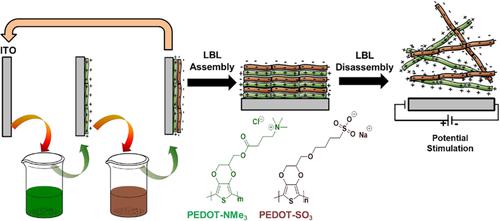当前位置:
X-MOL 学术
›
J. Chin. Chem. Soc.
›
论文详情
Our official English website, www.x-mol.net, welcomes your
feedback! (Note: you will need to create a separate account there.)
Layer‐by‐layer assembly and electrically controlled disassembly of water‐soluble Poly(3,4‐ethylenedioxythiophene) derivatives for bioelectronic interface
Journal of the Chinese Chemical Society ( IF 1.6 ) Pub Date : 2020-08-18 , DOI: 10.1002/jccs.202000146 Bhaskarchand Gautam, Hailemichael Ayalew, Udesh Dhawan, Jayakrishnan Aerathupalathu Janardhanan, Hsiao‐hua Yu
Journal of the Chinese Chemical Society ( IF 1.6 ) Pub Date : 2020-08-18 , DOI: 10.1002/jccs.202000146 Bhaskarchand Gautam, Hailemichael Ayalew, Udesh Dhawan, Jayakrishnan Aerathupalathu Janardhanan, Hsiao‐hua Yu

|
Poly(3,4‐ethylenedioxythiophene (PEDOT) derivatives display a multitude of attractive properties such as high conductivity, biocompatibility, ease of functionalization, and high thermal stability. As a result, they show promise for applications in materials and biomedical engineering. In order to increase their applications in the practical domain, trivial fabrication techniques are required. Here, we present a simple layer‐by‐layer dip methodology to assemble water‐soluble PEDOT derivatives that can then be disassembled via electrical stimulation. As a result, a dynamic PEDOT layered system is fabricated and could be applied as responsive materials for bioengineering. PEDOT‐SO3 and PEDOT‐NMe3 are synthesized via direct C‐H arylation polymerization and chemical polymerization, respectively. The electrostatic interactions between oppositely charged SO3− and NMe3+ enabled the stacking of PEDOT derivatives. The layer‐by‐layer assemblies are confirmed by ultraviolet–visible spectroscopy and profilometer. Morphological analyses are performed using scanning electron microscopy and atomic force microscopy, which revealed that the polymer coatings are uniform without any cracks. In situ material assembly is studied using quartz crystal microbalance, and we also demonstrate that these PEDOT‐derivative assemblies can be disintegrated by electrical stimulation. Cyclic voltammetry shows a proportional increase in stored charge density with the increase in bilayer thickness, confirming stable electroactivity of these assemblies. Using this approach, we can assemble conductive bio interface on both conductive and nonconductive surfaces, expanding the capability to fabricate bioelectronic electrodes.
中文翻译:

用于生物电子界面的水溶性聚(3,4-乙撑二氧噻吩)衍生物的逐层组装和电控拆卸
聚(3,4-乙撑二氧噻吩(PEDOT)衍生物具有多种吸引人的特性,例如高电导率,生物相容性,易于官能化和高热稳定性,因此,它们在材料和生物医学工程中具有广阔的应用前景。为了增加它们在实际领域中的应用,需要简单的制造技术,在这里,我们提出一种简单的逐层浸渍方法来组装水溶性PEDOT衍生物,然后可以通过电刺激将其分解。 PEDOT分层系统已制成,可以用作生物工程的响应材料PEDOT-SO 3和PEDOT-NMe 3分别通过直接CH芳基化聚合和化学聚合合成。相反之间的静电相互作用带电SO 3 -和NME 3 +启用了PEDOT衍生物的堆叠。逐层组装通过紫外可见光谱仪和轮廓仪确认。使用扫描电子显微镜和原子力显微镜进行形态分析,结果表明聚合物涂层是均匀的,没有任何裂纹。使用石英晶体微量天平对原位材料组装进行了研究,我们还证明了这些PEDOT衍生组件可以通过电刺激来分解。循环伏安法显示,随着双层厚度的增加,存储的电荷密度成比例地增加,证实了这些组件的稳定电活性。使用这种方法,我们可以在导电和非导电表面上组装导电生物界面,从而扩展了制造生物电子电极的能力。
更新日期:2020-09-24
中文翻译:

用于生物电子界面的水溶性聚(3,4-乙撑二氧噻吩)衍生物的逐层组装和电控拆卸
聚(3,4-乙撑二氧噻吩(PEDOT)衍生物具有多种吸引人的特性,例如高电导率,生物相容性,易于官能化和高热稳定性,因此,它们在材料和生物医学工程中具有广阔的应用前景。为了增加它们在实际领域中的应用,需要简单的制造技术,在这里,我们提出一种简单的逐层浸渍方法来组装水溶性PEDOT衍生物,然后可以通过电刺激将其分解。 PEDOT分层系统已制成,可以用作生物工程的响应材料PEDOT-SO 3和PEDOT-NMe 3分别通过直接CH芳基化聚合和化学聚合合成。相反之间的静电相互作用带电SO 3 -和NME 3 +启用了PEDOT衍生物的堆叠。逐层组装通过紫外可见光谱仪和轮廓仪确认。使用扫描电子显微镜和原子力显微镜进行形态分析,结果表明聚合物涂层是均匀的,没有任何裂纹。使用石英晶体微量天平对原位材料组装进行了研究,我们还证明了这些PEDOT衍生组件可以通过电刺激来分解。循环伏安法显示,随着双层厚度的增加,存储的电荷密度成比例地增加,证实了这些组件的稳定电活性。使用这种方法,我们可以在导电和非导电表面上组装导电生物界面,从而扩展了制造生物电子电极的能力。











































 京公网安备 11010802027423号
京公网安备 11010802027423号